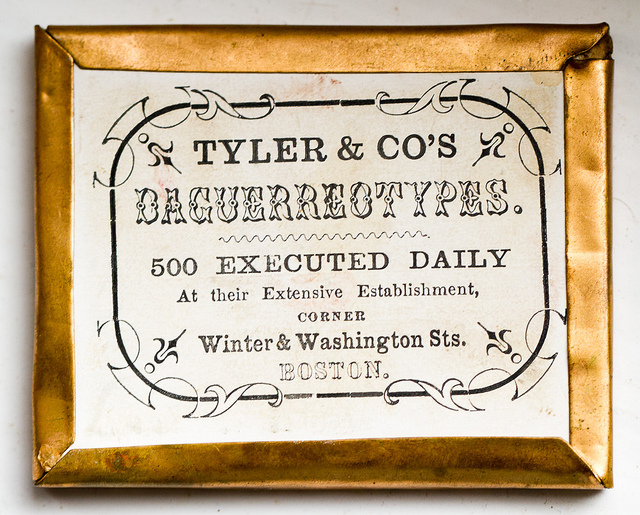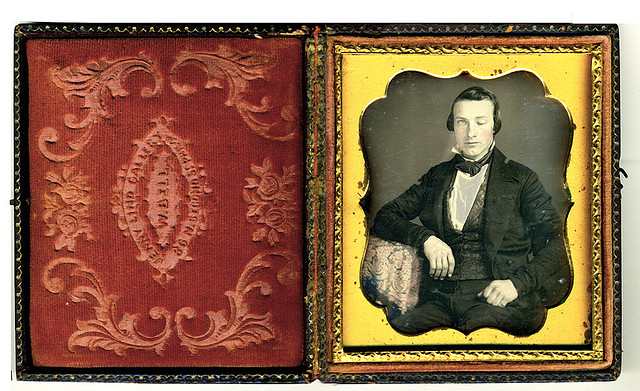by Nicole Zimmerman

Daguerreotype Business Card npurmort, used under 
Photography is a beautiful from of art that was evolved into many forms over centuries. A popular type of photography that came about in the 19th century is, the Daguerreotype.

George Eastman House Camera Obscura
by Robert Taylor, used under 
Daguerreotype started with a successful commercial artist by the name of Louis Jacques Mande Daguerre in Paris in 1825 (Nelson, 1996). He started experimenting with a camera obscura to put the surroundings that his eye saw in 3D into a 2D image. Daguerre soon became aware of Joseph-Nicephore Niepce who was trying to do something similar.
Niepce was trying to “use light to create plates that could be inked and printed to produce accurate reproductions or original works of scene” (Nelson, 1996). Unfortunately Niepce died before anything substantial came about from this collaboration, however; Daguerre did learn a lot.
In 1837, Daguerre came up with a method to produce a photographic image. This process involves treating a silver-plated copper sheet with iodine. Adding the iodine, to the sheet makes it sensitive to light. The sheet is then exposed in the camera. Then the sheets are “developed” into images with warm mercury vapor (Nelson, 1996).
Daguerre published the steps of this process on August 19, 1839, with the help of the French (Nelson, 1996). Within just a few months of publication, an instruction manual could be found around the world in various translations.
This video goes into a more detailed description of the Daguerreotype process. 

belladaguerreotype
by Bill Becker, used under 
With the invention of the daguerreotype process became what is known as the Daguerrian Era. The world loved the look of this photography, especially in America. The fascination lasted for nearly 20 years. By 1843, a daguerreotype portrait industry had evolved into society. A person’s portrait could be put onto a silver plate, framed, and put into a leather case for anywhere from $2-5 (Nelson, 1996).
Daguerreotypes were regarded as “mirrors of truth” due to their brilliance and clarity. They were said to reveal the soul of the person in the portrait. Eventually, professional journals appeared for artists to showcase their work along with various competitions for honors such as prestige and medals. By the 1850’s, millions of daguerreotypes had been made to capture almost every aspect of life.
Despite the brilliance and captivating look of a Daguerreotype image, there were some disadvantages to this photographic process. The reflections from the mirror-like sheet made it difficult to see the image. The photograph was very heavy due to the metal and difficult to make in larger sizes. The delicate surface required a protective glass and bulky case or frame to protect the image (Nelson 1996). Even though Daguerreotypes are a unique original, there was no negative to make multiple prints. This was seen as a downfall, and ultimately led to the decline in popularity of the Daguerreotype.

img-003
by Camera Wiki, used under  (left)
(left)
Aparición de la imagen
by Biblioteca de la Facultad de Derecho y Ciencias del Trabajo…
, used under  (middle)
(middle)
Daguerreotype of Unknown Man
by Claudet, used under  (right)
(right)
Nelson, K. E. (1996). A Thumbnail History of the Daguerreotype. Retrieved 04 02, 2014, from The Daguerreian Society: daguerre.org/resource/history/history.html